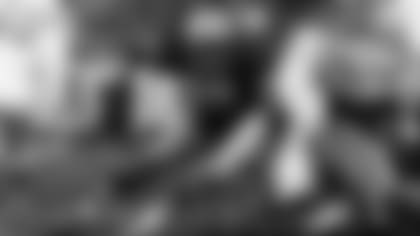Over a span of seven years, from when the newly formed American Football League held its first draft on Nov. 22, 1959 until a merger agreement with the National Football League was reached in June 1966, the two leagues held separate college drafts and engaged in expensive bidding wars to sign their picks.
The Green Bay Packers lost only one of nine No. 1 choices during that period and it proved to be no loss. Wide receiver Larry Elkins, selected with the Packers' second first-round pick and 10th choice overall in the 1965 draft, signed with the Houston Oilers and turned out to be a bust. He played two years and caught a total of 24 passes.
Still, the Packers lost a quarterback who could have become Bart Starr's heir apparent and four solid offensive linemen.
Losing those four might also explain why of the nine players who survived Vince Lombardi's nine seasons as head coach, four were offensive linemen, including Forrest Gregg, Jerry Kramer, Bob Skoronski and Fuzzy Thurston.
Lombardi once said the key to sustaining success in the NFL, from a personnel standpoint, was knowing when to get rid of players.
"Football is a hardheaded cold business," Lombardi preached. "No matter what a player did last year, he must go if he can't do it this year."
While the results maybe didn't reflect it, Lombardi looked to turn over his offensive line the same as he did everywhere else. He made two permanent changes: Ken Bowman took over as the starting center in the eighth game of the 1964 season, essentially replacing perennial all-pro Jim Ringo, and Gale Gillingham beat out Thurston in 1967 after filling in for him over the last two regular-season games of 1966.
But Lombardi also tried to make other changes that didn't work out as well.
In 1963, he began the season alternating Skoronski and Norm Masters, who was actually the older of the two by seven months, at left tackle, but scrapped the plan at midseason. Thereafter, Masters started six of the last seven games. In 1964, second-year pro Dan Grimm replaced Thurston for the final seven games. A year later, Lombardi moved Gregg to left guard and started second-year man Steve Wright at right tackle until the 12th game when he reinserted Thurston at left guard and switched Gregg back to right tackle.

Here were the Packers' five biggest losses to the AFL, including the round and year they were drafted. But first, one footnote: The Packers drafted future Hall of Fame defensive tackle Buck Buchanan as a future in the 17th round in 1962, but the pick was voided. Thus, Buchanan wasn't considered.
- Daryle Lamonica (12th round, 1963) – The AFL held its draft on Dec. 1, 1962, two days before the NFL, and the Buffalo Bills announced 13 days later they had signed Lamonica, their 24th round choice. "I'm going with the Bills because they gave me a better one-year offer," explained Lamonica. "I don't intend to play pro ball the rest of my young life. I have other things in mind." The quarterback who became known as "The Mad Bomber" as a pro struggled as a senior at Notre Dame under Joe Kuharich much like Joe Montana did later under Dan Devine. In fact, Kuharich considered Lamonica a better runner, but thought junior Frank Budka was the better passer because he threw a better deep ball. So he had them split time. 1963 wasn't one of Notre Dame's more memorable seasons and Lamonica was the subject of one of the better stories that circulated in South Bend. Apocryphal or not, it went like this. One day a priest encountered him on a golf course and asked why he wasn't at practice. Lamonica responded, "I don't have to practice. I know both of Kuharich's plays." So the priest, in need of a golf partner the next day, asked Lamonica to join him. "Can't make it today," said the quarterback. "I have to find out which play Joe wants to use Saturday." Following a 35-6 loss to Northwestern, Notre Dame was scheduled to play Navy next. That week, the Midshipmen's chief scout Steve Belichick told the Baltimore Sun that Notre Dame's biggest problem was quarterback because four players were sharing the position. But Belichick added that he liked what he saw of Lamonica, despite the lopsided score, when he got a chance to play in the second half against Northwestern. "He gave them the best passing they've had all year," Belichick said. Sure enough, against Navy, Lamonica outplayed sophomore Roger Staubach and triggered a four-game winning streak for the Irish. After signing with Buffalo, Lamonica spent four years backing up veteran Jack Kemp, but went 4-0 in his only starts. Traded to Oakland in 1967, Lamonica led the Raiders to a 13-1 regular-season record, the AFL championship and a matchup with Green Bay in Super Bowl II. He also was named the AFL's Player of the Year. The week before the Super Bowl, Green Bay native Red Smith, who would win a Pulitzer Prize nine years later, interviewed George Wilson, who had coached Detroit from 1957-64 and also had faced Lamonica three times as coach of the Miami Dolphins. Asked to compare the two teams, Wilson said he thought Lamonica would be the key to the game. "I believe the two hottest quarterbacks in professional football through the season were Sonny Jurgensen with the Redskins and Lamonica in our league," said Wilson. Although Starr outplayed Lamonica in the Super Bowl, the latter compiled a 62-16-6 record as Oakland's starter before being replaced by future Hall of Famer Ken Stabler in 1973. When the Raiders acquired Lamonica, Ron Wolf was a 29-year-old scout in his fifth year with the team. Wolf has no doubt Lamonica would have eventually played for the Packers. "He threw 30 touchdown passes his first year, 34 another year," said Wolf. "The team went 13-1 with him as a quarterback. He had a strong arm. He could make all the throws. Plus, he was agile enough to get out of trouble." In Wolf's eyes, Lamonica might have been the second best quarterback in AFL history. "Of his era, there wasn't anybody as good as Joe Namath," said Wolf. "Joe Namath was a cut above everybody else. He's in the Hall of Fame. But Daryle would be No. 2. (Len) Dawson is in the Hall of Fame, but I think Daryle was better than Dawson. (George) Blanda is in the Hall of Fame. But Daryle could make all the throws." No doubt, Lamonica was better than any Packers' quarterback between Starr and Lynn Dickey, but he would have been 29 years old when Starr's shoulder problems signaled the end was near in 1969.
- Jon Morris (2nd round, 1964) – The Packers chose Morris six rounds before Bowman, who started at center for the Packers for most of the next 10 years. Morris signed with the then Boston Patriots and played 15 years. He played in six AFL All-Star Games and the first Pro Bowl following the merger. He's also the only center in the Patriots Hall of Fame and was named the center on their 50th Anniversary team. So would Morris have beaten out Bowman if they both had signed in Green Bay? Wolf wavered. "I'm sure he could have done that," Wolf said before having second thoughts. "But, to me, Bowman was so tough. That would have been an interesting competition." Drafted by the Patriots in the fourth round after playing collegiately at Holy Cross, Morris signed 20 days after the draft. He said he received comparable offers but wanted to go to law school and thought his options would be better in Boston. When he joined the Chicago Bears in 1978 for his final season, Morris also admitted, "Jim Ringo was the center in Green Bay and I figured I'd never get to play."
- Paul Costa (4th round, 1964) – A 6-foot-4, 232-pound halfback at Notre Dame, Costa was one of the Packers' two fourth-round draft picks. He also had a year of eligibility remaining and couldn't sign until he finished his senior season. By then, Notre Dame had moved him to defensive end and Costa's AFL draft rights had been traded from Kansas City, which selected him as a future in the 14th round in 1964, to Buffalo. Two days after the AFL's 1965 draft, Costa signed with the Bills, where he played from 1965-72. He started eight games at tight end as a rookie and then started in the AFL All-Star Game. Costa played tight end for four years, catching 102 passes and averaging 16.7 yards per catch, before moving to offensive tackle for his final four seasons. Considering Lombardi benched tight end Marv Fleming in 1965 to play journeyman Bill Anderson, Costa might have gained a foothold on that position if he had signed with the Packers. Wolf said he didn't know if Costa also could have pushed for a starting job at tackle, but added, "A guy like Costa would have done something."
- Joe O'Donnell (3rd round, 1964) – The Packers used one of three third-round choices on O'Donnell, but he decided soon after the draft he was going to sign with Buffalo, which took him in the 13th round. The Winnipeg Blue Bombers, then coached by Bud Grant, also made a pitch for O'Donnell. Captain at the University of Michigan as a senior, O'Donnell became the Bills' starting right guard in his third season, missed the 1968 season with a knee injury and then started for most of his last three seasons, blocking for O.J. Simpson on bad teams and before he became a 1,000-yard rusher. "A love-of-the-game guy," is how the Bills described O'Donnell in their 1969 yearbook. "Tough guy," said Wolf. "He would have fit in perfectly with what they did here under Lombardi."
- Len St. Jean (17th round, 1964) – A product of Northern Michigan University and Newberry, a small town in Michigan's Upper Peninsula, St. Jean opted to sign with the then Boston Patriots, which had selected him in the ninth round of the AFL draft. Actually, St. Jean planned to sign with the Patriots immediately after the AFL draft because a former Northern Michigan teammate, halfback Tom Neumann, had made their roster as a rookie in 1963. When the Packers drafted him, St. Jean had second thoughts but stuck with his original decision. "The ice has already been broken there," St. Jean said of Boston. Undersized at 6-foot, 240 pounds, St. Jean was projected as a defensive end by the Packers. The Patriots tried him at linebacker, defensive end and tackle, as well as guard. An immediate standout on kick coverage, St. Jean became a starting guard in his third season and was selected for the AFL All-Star Game. In all, he played 10 seasons and started at right guard through 1973, compensating for his lack of height with strength. "Boston Strong Boy" was his nickname. "One of the most underrated linemen in football," his line coach Bruce Beatty once said. O'Donnell and St. Jean edged halfback Ode Burrell, also one of three third-round picks by the Packers in 1964, for the final two spots. In his second year with the Oilers, Burrell rushed for more than 500 yards and caught 55 passes.
















